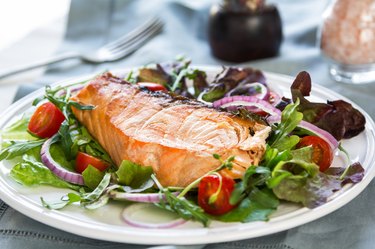
The number of calories you need if you're a 220-pound man varies based on several different factors, including your age, activity level and body composition. You can figure out a good estimate, however, to narrow down how much you should be eating each day -- whether your goal is to lose, gain or maintain your weight.
Basic Calorie Needs for a 220-Pound Man
Video of the Day
A 220-pound man who isn't very active needs about 14 calories per pound each day, which translates to about 3,080 calories. For a more accurate estimate of your calorie needs, start by calculating your basal metabolic rate, or BMR, which is the number of calories you need each day just to keep your body functioning without any extra activity.
Video of the Day
For men, this rate is determined by this equation: BMR = 66 + (6.23 x weight in pounds) + (12.7 x height in inches) - (6.8 x age in years).
As an example, a 220-pound man who's 5 feet, 10 inches tall and 30 years old has a BMR of 2,122 calories. Multiply the result by an activity factor to determine total calorie needs.
Effect of Activity Level
Once you've calculated your BMR, either by using an online calculator or the equation, factor in your activity level. If you get little or no exercise, multiply your BMR by 1.2, and, if you get some light exercise one to three days a week, multiply it by 1.375. Multiply your BMR by 1.55 if you're moderately active, by 1.725 if you're very active, and 1.9 if you're extremely active. Thus, the 220-pound man needs about 2,550 calories if he's sedentary or about 3,290 calories if he's moderately active.
Effects of Age
As people get older, their metabolisms slow down, at least partly from losses in muscle. This metabolism decrease means that men often gain an extra 3.4 percent of their body weight every 10 years. Metabolism slows about 2 percent every 10 years after the age of 20, which means you need to eat about 150 fewer calories a day when you're 40 than you did when you were 30. Calorie-needs calculators include age in their calculations because of the typical metabolism decreases, but you can minimize the effect if you work out regularly and include both strength training and cardio exercises in your regime.
Effect of Body Composition
The greater percentage of muscle you have in your body, the higher your metabolism and your daily calorie needs. Each pound of muscle takes about 6 calories per day to maintain, while a pound of fat only takes about 2 calories per day. So a muscular 220-pound man needs more calories per day than one who has a high body fat percentage. You can use an online lean body mass calculator to estimate how much of your weight most likely consists of muscle, or visit a trained professional to have your body fat percentage calculated using skinfold calipers. This service is also often offered at health clubs and gyms.
Calories to Change Weight
If you'd like to lose weight, determine how many calories you need daily to maintain your weight and then subtract 500 to 1,000 calories -- to slim down at a healthy rate of 1 to 2 pounds per week. The 220-pound, moderately active man in the example -- who needed 3,290 calories daily to maintain his weight -- can cut back to 2,290 calories if he wants to lose 2 pounds a week. Men should eat at least 1,800 calories per day, however, because going lower will slow down your metabolism. If cutting calories take you below 1,800, you may need to settle for a slower rate of weight loss or burn more calories via exercise.
On the other hand, if you're trying to gain weight, you should add 500 calories each day to gain a pound a week. Either way, get your calories mainly from nutritious foods, such as whole grains, lean proteins, low-fat dairy, fruits and vegetables and healthy fats such as olive oil, avocado and nuts. Limit the amount of highly processed foods, fatty foods and sweets that you eat.
- American College of Sports Medicine: Metabolism Is Modifiable With the Right Lifestyle Changes
- ShapeFit.com: Basal Metabolic Rate – How To Calculate and Find Your BMR
- American Council on Exercise: Caloric Cost of Physical Activity
- Muscle Evo: The Myth About Muscle and Metabolism
- American Council on Exercise: Is It True That Metabolism Decreases With Age?
- Calculator.net: Lean Body Mass Calculator